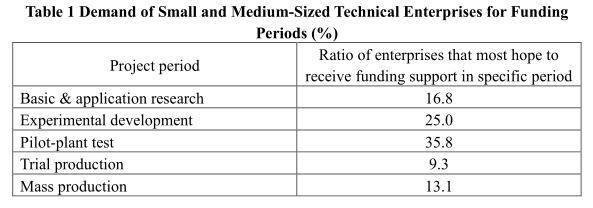An Analysis of the Policy Demand of Small and Medium-Sized Technology-based Enterprises
2005-02-11
Ma Mingjie
Government support for the development of small and medium-sized enterprises has become an international practice. In recent years, the development of China’s small and medium-sized enterprises has also received growing attention of the governments at all levels. The Law on the Promotion of Small and Medium-Sized Enterprises, the Innovation Fund for Small and Medium-Sized Technical Enterprises, the Fund for the International Market Development of Small and Medium-Sized Enterprises, and other policies, laws and regulations were introduced one after another. At a time when the government intensifies support, it is necessary to identify the policy demand of small and medium-sized enterprises and especially the technical ones so as to make these support policies more relevant and more practical. Based on the 1,259 returned survey questionnaires on small and medium-sized technical enterprises, this report attempts to make an analysis of the policy demand of these enterprises.
I. The Common Demand of Enterprises
1. The periods in which government funding is most needed: the periods of experiment, development and pilot-plant test
As many as 60.8 percent of the enterprises surveyed hope that the government

We can interpret the survey results in this way. First, the overall innovation capacity of China’s small and medium-sized enterprises is not strong; the technologies innovated by themselves are very few; and most of their technologies imitated or substituted foreign technologies. Therefore, they have very few projects in the period of basic and application research, and many projects for the periods after experimental development. Next, they need a relatively small amount of funds for basic and application research and they themselves can generally raise such funds. Their funding demand for the projects that have entered the period of trial production is great, and government funding is too little to meet their demand. Therefore, the dependence of enterprises on government for funding the projects in these periods is small. On the other hand, most of the projects that are in the periods of experimental development and pilot-plant test are in a difficult position where they do not have enough funds of their own and they find it difficult to raise funds externally. Therefore, government funding, though unable to meet all their demand, can ease their funding pressure.
2. The best funding methods for different project periods
Enterprises have different demand for government funding in different project periods. For the activities of basic and application research, experimental development and pilot-plant test, most enterprises believe that the government should support enterprises in the form of grants. The ratio is respectively 88.9 percent, 85.5 percent and 69.7 percent for the three periods. For the activities of trial production and mass production, nearly half enterprises believe that discount loans are the best way of funding (table 2).

As corporate activities move from research and development to the competition period, the ratio of enterprises that demand government grants drops drastically from 88.9 percent to 15.9 percent. But the ratio of enterprises that demand discount loans rises sharply from 3.8 percent to 48.5 percent and the ratio of enterprises that demand government capital participation and payable funding also becomes visibly higher.
The turning point for a drastic reduction in the demand for grants occurs in the period of trial production, with the demand for this period being only half of that for the period of pilot-plant test. The turning point for a drastic increase in the demand for discount loans occurs in the period of pilot-plant test, with the demand for this period being nearly three times higher than for the period of experimental development. The turning point in the demand for capital participation also occurs in the period of pilot-plant test, with the demand for this period being two times higher. The turning point for a visible increase in the demand for payable funding occurs in the period of mass production.
3. The best funding ratios for different project periods
The best funding ratio also changes with the progress of corporate projects. For basic and application research, the proportions of the enterprises believing the

funding ratio should be between 10 percent and 30 percent and between 30 percent and 50 percent are respectively 33.5 percent and 25.5 percent. For experimental development, 72.4 percent of enterprises believe that the funding ratio should be between 10 percent and 50 percent. For pilot-plant test, nearly 80 percent of enterprises believe the funding ratio should be between 10 percent and 50 percent. For experimental production activities, 74.1% percent of enterprises agree that the funding ratio should be between 10%-50%. For mass production, the opinion of the enterprises changes. The proportion of those believing the funding ratio should be between 10 percent and 30 percent is drastically smaller, while that of those believing the funding ratio should be more than 50 percent is visibly higher, reaching 28.6 percent (table 3).
In general, for the corporate activities before trial production, the proportion of the enterprises believing the funding ratio should be between 10 percent and 30 percent is the largest. As the period of mass production is rather special, corporate views are widely divergent. But compared with other periods, the ratios of government funding requested by enterprises are visibly higher. While the proportion of the enterprises requesting a funding ratio of between 30 percent and 50 percent declines, that of the enterprises requesting a funding ratio of more than 50 percent is twice as high as that for the preceding period. What is noteworthy is that more than 80 percent of enterprises believe that the ratio of government funding should not exceed 50 percent no matter for which period of corporate activities.
…
If you need the full text, please leave a message on the website.














